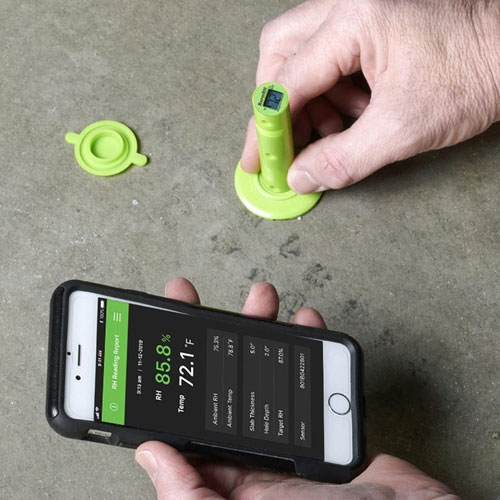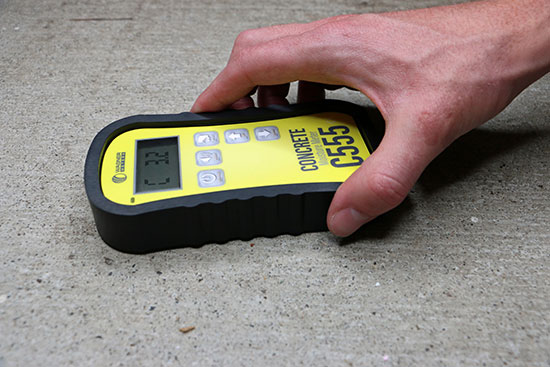How Moisture Testing Improves Efficiency and Reduces Waste
What does it look like for flooring contractors to “go green”?
As a flooring contractor, you may have to report to a general contractor on how you’re reducing waste. And even if you don’t, you’re no doubt mindful of the need to care for the environment.
Is it possible to do so while still being efficient?
With moisture testing, yes! Moisture testing of flooring and subflooring can help reduce both wasted time and materials.
We’ll look at how the right tools for measuring moisture and relative humidity accomplish that. But first, a little on moisture and its effect on flooring.
Understanding Moisture and Flooring

Moisture testing of flooring and subflooring is an important way to reduce wasted time and materials.
Whether liquid or vapor, moisture impacts flooring materials and can wreak havoc on them if not managed properly. Wood, as a living material, will release or absorb moisture to match the moisture content of its environment. That means wooden floorboards will shrink or expand in response to moisture conditions.
Concrete, which requires water when first poured, dries over time and loses moisture.
But just because concrete has cured does not mean it has dried sufficiently. Excess moisture can creep into the wood flooring above it and cause problems.
And wood floors are not the only ones affected. Even various types of resilient and engineered wood flooring require proper moisture conditions—and can be damaged if the concrete subfloor has too much moisture.
In residential flooring projects, here are some potential sources of moisture:
- Exposure of the concrete to rain or snow before the building was enclosed
- Not allowing the concrete enough time to dry
- Poor drainage around the building
- High humidity and condensation due to an uncontrolled environment
And unfortunately, the excess moisture can contribute to serious problems and waste.
How Moisture Leads to Waste in Residential Flooring Projects
Moisture damage can’t always be repaired. Sometimes, the damage is irreparable, and the contractor has to strip out materials and throw them away.
Here are some potential causes:
A flooring contractor failed to measure the flooring’s moisture content to know whether it had acclimated before installation.
Or maybe the floor covering was perfectly ready, but the contractor never checked the concrete subfloor.
After all, it’s not enough to “eyeball” concrete. It may look dry, but that’s because concrete forms a gradient when it dries—it has more moisture on the bottom and less on top. But that moisture eventually creeps up and can cause problems such as:
- Warping of wood floor materials
- Adhesive failures—Many newer adhesives are more sensitive to moisture. Many older adhesives are no longer used because of bans on certain VOCs in adhesives.
- High concrete alkalinity—which can also damage adhesives
- Efflorescence—As moisture comes up from the concrete, it may bring up minerals in the concrete slab mixture that cause a white residue.
But let’s say the concrete has a relative humidity under 75% (as required by British Standard Codes of Practice), and the flooring has acclimated.
Even then, problems can occur if the jobsite doesn’t have a consistent humidity level and a temperature between 18° C and 27° C. Significant fluctuations in ambient conditions can cause damage to the floor and the need to replace materials.
Think about the time that’s wasted too.
Not testing for moisture may seem more efficient at the outset.
But when you have flooring failures and callbacks, you end up spending more time on a job you thought was finished. This takes away time and energy you could have spent on new projects.
Here are some other causes of inefficiency with flooring projects:
- Improper or insufficient moisture testing of the floor covering and subfloor
- Time-consuming and messy concrete moisture testing methods—many of which take 72 hours to equilibrate
- Not having moisture testing protocols
- Having to record all your moisture measurements manually
Thankfully, there are tools that can make the moisture testing process easy to do.
The Rights Tools to Reduce Waste
Wagner Meters offers three tools that can make moisture measurements much quicker and more efficient.
Rapid RH®
The Rapid RH test involves drilling and inserting in situ probes into the concrete slab (check first for heating coils with thermal imaging or radar detection tools). Per ASTM F2170, it’s the most accurate testing method for concrete relative humidity because it gives you the overall moisture condition of the slab—not just the surface moisture condition.
Unlike many other concrete moisture testing methods, the Rapid RH takes only 24 hours to equilibrate. And once it’s at equilibrium, you can repeatedly test and get results in as little as 2 minutes—that’s about ten times faster than other tests!
Think about all the installation time you’ll save!
And the next tool can help reduce the number of probes you’ll need to use.
C555 Concrete Moisture Meter

The right tools and protocols can make moisture testing easy to perform.
The C555 concrete moisture meter doesn’t measure at the same depth as the Rapid RH. But in conjunction with the Rapid RH, the C555 can help you find moisture hotspots and know where to insert your probes.
Strategically placing your Rapid RH probes can save you time and give you more useful RH test results. And you won’t waste probes testing areas that may already be dry enough.
But what about once the floor is installed? Is there a way to prevent significant temperature/humidity fluctuations and minimize the risk of damage?
That’s where Floor Sentry® comes in.
Floor Sentry
Floor Sentry is an effective way to monitor conditions once a wood floor has been installed. It empowers homeowners to care for their floors. And it makes it less likely you’ll be accused of a flooring failure that had nothing to do with your work and everything to do with improper environmental control.
Floor Sentry is a small device that can be inserted on the underside of a wood floor plank. It connects via Bluetooth® to a mobile device, allowing homeowners to monitor wood floor and subfloor conditions.
The app takes readings consistently and stores them. And it will immediately send an alert when those conditions go out of an acceptable range and could cause damage.
In this way, you put floor protection and maintenance into the hands of your clients.
Become More Efficient in Your Work Today
Ready to move toward a more time and cost-effective work model? Tools like Rapid RH, the C555 concrete meter, and Floor Sentry can help you give your clients the best. You’ll have confidence that you’re doing your part to prevent waste too.
And unlike some ecological measures that feel burdensome, these tools promise to make you more efficient! Get yours today by visiting WagnerMeters.com.
Jason has 20+ years’ experience in sales and sales management in a spectrum of industries and has successfully launched a variety of products to the market, including the original Rapid RH® concrete moisture tests. He currently works with Wagner Meters as our Rapid RH® product sales manager.
Last updated on March 11th, 2025



